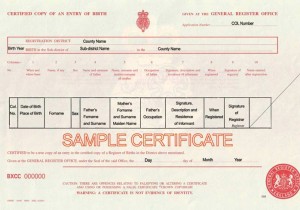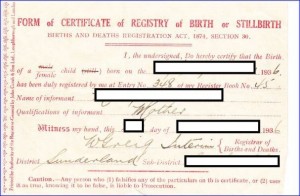This week I want to talk about birth certificates. I’ve covered these before – see the page “Birth, Marriage, Death” – but I’m going to go into a little more details about the different types of birth certificate.
The Long Form
This is the type of certificate we’re all familiar with: besides giving the name of the child and date of birth, it also gives details of addresses; mother’s full name, maiden name and (if she’s been married before) her previous married names; and the father’s full name and his occupation. This is the sort of information we need to trace the our ancestors: armed with this information you should now be able to find details of the parents’ marriage, and to trace their lives through the census returns.
The Short Form (1)
This form of certificate is that which is issued to a parent on the registration of the birth, and which can still be obtained from the Registrar.
As you can see, only the baby’s details are shown. For our purposes, as family historians, it has little value, but, sadly for us, is the most common form of certificate handed down the family. If you find this type of certificate amongst your family papers, sadly it is of little use to you as a family historian: you will need to obtain a copy of the full certificate.
(Don’t ever throw away the certificate which you have however! File it in your family archive.)
The Short Form (2)
I must admit that I wasn’t aware of this type of certificate (which seems to have been issued until at least the 1940s) until a few months ago.
As you can see, the information given on this form is minimal: the date of birth and sex of the child is stated, but not the name. On this example, the mother’s name was given, but only because she was the informant.
If you find this sort of certificate amongst your family papers, you need to be aware of two things: again the certificate is of little use to you, and you need to obtain a full certificate. Secondly, please don’t be confused by the fact that the heading is ”Birth or Stillbirth”. The form doesn’t mean that the child was stillborn – you can see on the form that it could be used for either a still or a live birth, and that where there was a live birth the appropriate words were deleted. If however, it was used to record a stillbirth, this may be the only record you’re likely to find of the event, because the Register of Stillbirths (introduced on 1 July 1927) is closed to all but the parents of the child, or, where both parents have died, to a sibling of the stillborn child.
You may, however, find details of a stillbirth in the Historic Stillbirth Register: www.anguline.co.uk/stillbirths.html
Finally, please don’t forget the magic date in family history: 1837. Civil Registration of births, marriages and deaths were only introduced on that date. Although it is possible that the birth of a child in late May or June 1837 may be registered (because there is a period of 42 days in which to register the birth) there are no certificates for births occurring in earlier periods.



